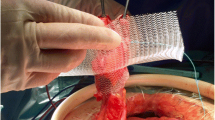Abstract
Background
Hernias around ostomies are a very common complication, exceeding 50%. Only a few studies deal with the prophylactic use of mesh to prevent parastomal hernia revealing promising results.
Patients and methods
Twenty-two patients undergoing elective rectal surgery with a permanent colostomy—one with an ileostomy and two needing surgical correction of a preexisting colostomy—were enrolled in a prospective study. A specially designed mesh made of polyvinylidene fluoride with a central whole and a funnel arising (Dynamesh IPST®) was prophylactically implanted using an intraperitoneal onlay technique. The patients were followed for a median of 11 (range 2–19) months by clinical examination every 3 months.
Results
No infection or any other adverse effect was observed, and no parastomal hernia or stoma protrusion could be detected clinically. Twelve patients had a routine computed tomography after 6 months, which also excluded any hernia formation.
Conclusion
The prophylactic use of Dynamesh IPST® is a safe and effective procedure preventing stoma complications such as hernia formation or prolapse, at least in the short run.

Similar content being viewed by others
References
Leslie D (1984) The parastomal hernia. Surg Clin North Am 64:407–415
Cheung MT (1995) Complications of an abdominal stoma: an analysis of 322 stomas. Aust N Z J Surg 65:808–811
Kasperk R, Willis S, Klinge U, Schumpelick V (2002) Update on incisional hernia. Parastomal hernia. Chirurg 73:895–898
Carne PW, Robertson GM, Frizelle FA (2003) Parastomal hernia. Br J Surg 90:784–793
Cingi A, Cakir T, Sever A, Aktan AO (2006) Enterostomy site hernias: a clinical and computerized tomographic evaluation. Dis Colon Rectum 49:1559–1563
Leong AP, Londono-Schimmer EE, Phillips RK (1994) Life-table analysis of stomal complications following ileostomy. Br J Surg 81:727–729
Londono-Schimmer EE, Leong AP, Phillips RK (1994) Life table analysis of stomal complications following colostomy. Dis Colon Rectum 37:916–920
Ortiz H, Sara MJ, Armendariz P, de Miguel M, Marti J, Chocarro C (1994) Does the frequency of paracolostomy hernias depend on the position of the colostomy in the abdominal wall? Int J Colorectal Dis 9:65–67
Ortiz H (1995) Does the difference in muscle structure of the rectus abdominis muscle of patients wearing a colostomy or ileostomy explain the different frequency of parastomal hernias? Int J Colorectal Dis 10:55
Sjodahl R, Anderberg B, Bolin T (1988) Parastomal hernia in relation to site of the abdominal stoma. Br J Surg 75:339–341
Klinge U, Si ZY, Zheng H, Schumpelick V, Bhardwaj RS, Klosterhalfen B (2001) Collagen I/III and matrix metalloproteinases (MMP) 1 and 13 in the fascia of patients with incisional hernias. J Invest Surg 14:47–54
Klinge U, Conze J, Krones CJ, Schumpelick V (2005) Incisional hernia: open techniques. World J Surg 29:1066–1072
Klinge U, Klosterhalfen B, Ottinger AP, Junge K, Schumpelick V (2002) PVDF as a new polymer for the construction of surgical meshes. Biomaterials 23:3487–3493
Junge K, Klinge U, Prescher A, Giboni P, Niewiera M, Schumpelick V (2001) Elasticity of the anterior abdominal wall and impact for reparation of incisional hernias using mesh implants. Hernia 5:113–118
Janes A, Cengiz Y, Israelsson LA (2004) Randomized clinical trial of the use of a prosthetic mesh to prevent parastomal hernia. Br J Surg 91:280–282
Janes A, Cengiz Y, Israelsson LA (2004) Preventing parastomal hernia with a prosthetic mesh. Arch Surg 139:1356–1358
Israelsson LA (2005) Preventing and treating parastomal hernia. World J Surg 29:1086–1089
Gogenur I, Mortensen J, Harvald T, Rosenberg J, Fischer A (2006) Prevention of parastomal hernia by placement of a polypropylene mesh at the primary operation. Dis Colon Rectum 49:1131–1135
Marimuthu K, Vijayasekar C, Ghosh D, Mathew G (2006) Prevention of parastomal hernia using preperitoneal mesh: a prospective observational study. Colorectal Dis 8:672–675
Cassar K, Munro A (2002) Surgical treatment of incisional hernia. Br J Surg 89:534–545
Le Blanc KA (2005) Incisional hernia repair: laparoscopic techniques. World J Surg 29:1073–1079
Pierce RA, Spitler JA, Frisella MM, Matthews BD, Brunt LM (2007) Pooled data analysis of laparoscopic vs. open ventral hernia repair: 14 years of patient data accrual. Surg Endosc 21:378–386
Berger D, Bientzle M (2007) Laparoscopic repair of parastomal hernias: a single surgeon’s experience in 66 patients. Dis Colon Rectum 50:1661–1668
Author information
Authors and Affiliations
Corresponding author
Rights and permissions
About this article
Cite this article
Berger, D. Prevention of parastomal hernias by prophylactic use of a specially designed intraperitoneal onlay mesh (Dynamesh IPST®). Hernia 12, 243–246 (2008). https://doi.org/10.1007/s10029-007-0318-0
Received:
Accepted:
Published:
Issue Date:
DOI: https://doi.org/10.1007/s10029-007-0318-0




